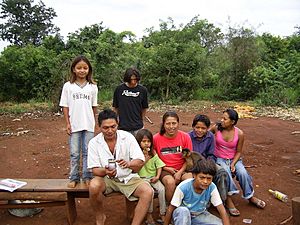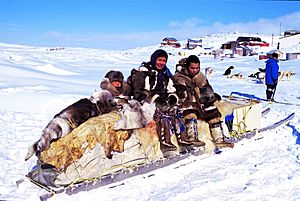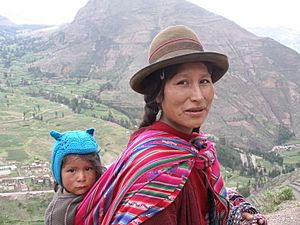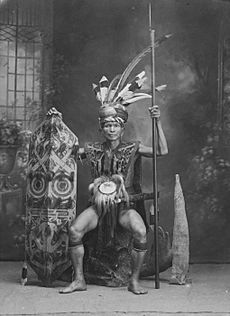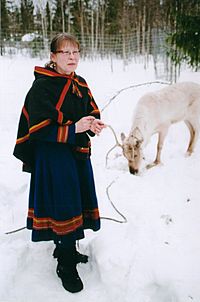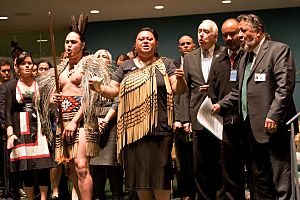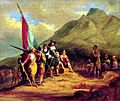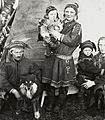Indigenous peoples facts for kids
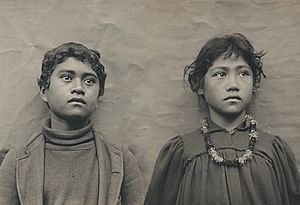
Indigenous peoples are groups of people who were the first to live in a certain area. They are also known as First Peoples, First Nations, Aboriginal Peoples, or Native Peoples in different parts of the world. These groups are different from people who settled or colonized the area more recently.
Indigenous groups often keep their old traditions, languages, and ways of life. However, some have also adopted parts of the cultures of people who came later. Indigenous people might live in one place or move around a lot, but they are always connected to a specific land that is important to them. You can find indigenous groups on every continent except Antarctica.
Sadly, many indigenous people faced hard times when new settlers arrived. During colonial times, they were often treated unfairly. Settlers sometimes took their lands and valuable items. Indigenous people also had to fight for their human rights and equality.
The International Day of the World's Indigenous Peoples is celebrated every year on August 9th.
Contents
Indigenous Peoples Around the World
Indigenous groups live in many different regions across the globe. Their numbers, living conditions, and experiences can be very different, even within the same region. It can also be tricky to count them because of how they are identified.
Indigenous Peoples in Africa

After colonial rule ended in Africa, the idea of specific indigenous peoples became more accepted. Africa has many different ethnic groups. Some of these groups, like herders or hunter-gatherers, live in ways that are often different from the main political and economic systems of their countries.
Since the late 1900s, these groups have been working to have their rights recognized as distinct indigenous peoples. They want this recognition both in their own countries and around the world. While most African peoples are "indigenous" because they come from Africa, the term "indigenous people" in modern times refers to groups who have been kept separate from the main state systems. Their traditional ways of life and land claims often clash with government plans or large companies.
Indigenous Peoples in the Americas
The indigenous peoples of the Americas are those groups and their descendants who lived there before Europeans arrived. These include people from the far north Arctic to the southern tip of Tierra del Fuego. Many still follow traditional ways of life.
When Europeans colonized the Americas, it had a very harsh impact on indigenous communities. Many people died, mainly from diseases brought by Europeans, but also from violence. Some groups even disappeared completely.
Every country in North and South America has indigenous populations. In some countries, especially in Latin America, indigenous peoples make up a large part of the total population. For example, in Bolivia, they are about 56–70% of the population. They also make up at least half the population in Guatemala and Peru.
In English, indigenous peoples are called by different names like Native Americans, Amerindians, or American Indians. In Spanish or Portuguese, terms like pueblos indígenas or povos nativos are used. In Chile, you can find the Mapuches and Aymaras. The Rapa Nui of Easter Island are a Polynesian indigenous group.
In Brazil, the term índio is commonly used. Brazil has the largest number of uncontacted peoples in the world, with 67 different groups confirmed in 2007.
Indigenous peoples in Canada include the First Nations, Inuit, and Métis. The terms "Indian" and "Eskimo" are no longer used in Canada. In 2016, there were about 1.67 million Aboriginal people. Canada has over 600 recognized First Nations governments with their own cultures, languages, art, and music. National Indigenous Peoples Day celebrates their contributions to Canadian history.
The Inuit have gained some self-rule with the creation of territories like Nunavik (in Quebec), Nunatsiavut (in Labrador), and Nunavut. Greenland is also home to a majority Inuit population (about 85%).
In the United States, Native Americans, Inuit, and other indigenous groups made up about 1.5% of the population in 2003. There are 563 federally recognized tribes. In Mexico, about 6 million people (6.7% of the population in 2005) identify as Indígenas. In southern states like Chiapas, Yucatán, and Oaxaca, they make up an even larger percentage.

Indigenous Peoples in Asia
Asia has the largest number of indigenous people in the world, about 70% of the global total.
Western Asia
The Armenians are the original people of the Armenian Highlands. Many Armenians now live outside their homeland due to past events.
The Yazidis are indigenous to the Sinjar mountains in northern Iraq. They are an ethnic Kurdish group but have their own religion. The Kurds are also an indigenous people of Mesopotamia (parts of Turkey, Syria, Iraq, Iran, and Armenia).
The Assyrians are indigenous to northern Iraq, southeastern Turkey, parts of Iran, and northeastern Syria. They believe they are descendants of the ancient Neo-Assyrian Empire. They still speak dialects of Aramaic, which was the official language of the Assyrian Empire.
South Asia
India has a large number of indigenous people, recognized as "Scheduled Tribes" in its constitution. These groups number around 200 million. However, the terms "indigenous people" and "tribal people" have different meanings.
Other indigenous groups live in the hills of Northern, North-eastern, and Southern India. These include the Tamils, Shina, Kalasha, Khowar, Burusho, Balti, Wakhi, Domaki, Nuristani, Kohistani, Bakkarwal, Meenas, Ladakhi, Lepcha, Bhutia (of Sikkim), Naga (of Nagaland), indigenous Assamese communities, Mizo (of Mizoram), Tripuri (Tripura), Adi and Nyishi (Arunachal Pradesh), Kodava (of Kodagu), Toda, Kurumba, Kota (of the Nilgiris), and Irulas.
India's Andaman and Nicobar Islands are home to groups like the Andamanese, Jarawas, Onge, and the uncontacted Sentinelese. The Indian government protects these groups. In Sri Lanka, the Veddah people are a small indigenous minority.
North Asia
Russians conquered the indigenous people of Siberia in the 17th and 18th centuries.
The Nivkh people are an indigenous group from Sakhalin. Their language is spoken by only a few people, and their fishing culture is at risk due to oil development. The Russian government recognizes only 40 ethnic groups as indigenous, even though more could be counted. This is because of their population size and how recently they arrived in their current regions.
East Asia
The Ainu people are indigenous to Hokkaidō, the Kuril Islands, and much of Sakhalin. As Japanese settlement grew, the Ainu were pushed north. They fought against the Japanese in revolts like Shakushain's Revolt. By the Meiji period, the government confined them to a small area in Hokkaidō, similar to how Native Americans were placed on reservations.
The Dzungar Oirats are indigenous to Dzungaria in Northern Xinjiang. The Pamiris are indigenous to Tashkurgan in Xinjiang. The Tibetans are indigenous to Tibet. The Ryukyuan people are indigenous to the Ryukyu Islands.
The languages of Taiwanese aborigines are very important in understanding how Austronesian languages spread across Oceania, as Taiwan was likely their origin point.
Southeast Asia
The Malay Singaporeans are the indigenous people of Singapore. They have lived there since the Austronesian migration and established the Kingdom of Singapura in the 13th century. The name Singapore comes from the Malay words "Singa" (Lion) and "Pura" (City), meaning "Lion City."
The Cham are the indigenous people of the former state of Champa, which was conquered by Vietnam. The Vietnamese government recognizes the Cham as a minority, but not as an indigenous people, even though they are native to the region.
The Degar (Montagnards) are indigenous to the Central Highlands (Vietnam) and were also conquered by the Vietnamese. The Khmer Krom are the indigenous people of the Mekong Delta and Saigon, which Vietnam gained from Cambodia.
In Indonesia, 50 to 70 million people are considered indigenous. However, the Indonesian government does not officially recognize "indigenous peoples." Instead, it classifies every Native Indonesian ethnic group as "indigenous," even though some groups have very distinct cultures. Many other countries in the ASEAN region share this issue.
In the Philippines, there are 135 ethno-linguistic groups. Most are considered indigenous peoples by the main indigenous groups in the country. The Igorot people are indigenous to the Cordillera Administrative Region and Cagayan Valley. The Lumad peoples and the Moro (like the Tausug, Maguindanao, and Maranao) are indigenous to Mindanao and the Sulu archipelago. Other indigenous groups live in Palawan, Mindoro, Visayas, and central/south Luzon. The Philippines has one of the largest indigenous populations in the world.
In Myanmar, indigenous peoples include the Shan, Karen, Rakhine, Karenni, Chin, Kachin, and Mon. Many other ethnic groups, such as the Akha, Lisu, Lahu, or Mru, are also considered indigenous.
Indigenous Peoples in Europe
In Europe, most ethnic groups have lived in their regions for centuries or thousands of years. However, only a few groups are recognized as indigenous by the UN definition. These are mainly found in northern and far eastern Europe.
Notable indigenous groups in Europe include the Finno-Ugric Nenets, Samoyed, and Komi peoples of northern Russia. Also, the Circassians of southern Russia and the North Caucasus, and the Sámi of northern Norway, Sweden, Finland, and Russia. This area is also called Sápmi.
Indigenous Peoples in Oceania
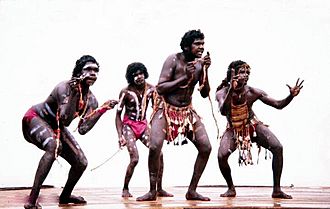
In Australia, the indigenous populations are the Aboriginal Australian peoples (with many different nations and tribes) and the Torres Strait Islander peoples. These groups are often called Indigenous Australians.
Many Pacific Island nations in Oceania were first settled by Polynesian, Melanesian, and Micronesian peoples thousands of years ago. European colonization later brought many of these islands under non-indigenous rule. In the 20th century, many former colonies became independent. However, some groups still seek indigenous recognition where their islands are under outside control. Examples include the Chamorros of Guam and the Northern Marianas, and the Marshallese of the Marshall Islands.
The remains of at least 25 small humans, who lived 1,000 to 3,000 years ago, were found on the islands of Palau in Micronesia.
In most parts of Oceania, indigenous peoples outnumber the descendants of colonists. Exceptions are Australia, New Zealand, and Hawaii. In New Zealand, Maori make up 14.9% of the population (2013 census). The Maori are indigenous to Polynesia and settled New Zealand around the 13th century CE. Before contact with Europeans, Maori peoples were not a single group. Many Maori leaders signed the Treaty of Waitangi with the British, which helped form modern New Zealand.
A majority of the Papua New Guinea (PNG) population is indigenous, with over 700 different nationalities recognized out of 8 million people. The country's Constitution supports traditional practices and land ownership. However, conflicts over land use and resources continue between indigenous groups, the government, and companies.
Related pages
Images for kids
-
Guatemalan girls in their traditional clothing from the town of Santa Catarina Palopó on Lake Atitlán.
-
Alonso Fernández de Lugo presenting the captured Guanche kings of Tenerife to Ferdinand and Isabella.
-
Map with the main travels of the Age of Discovery (began in 15th century).
-
Depiction of a Spaniard entering Chalco with three Tlaxcalan soldiers and an Indigenous porter in the Lienzo de Tlaxcala (pre-1585).
-
The arrival of Jan van Riebeeck in Table Bay, South Africa in 1652. Painting by Charles Davidson Bell (1813–1882).
-
A girl wears the traditional Nahua headdress in Yohualichan, Veracruz.
-
Kalash girls in Pakistan.
-
Ainu man performing a traditional Ainu dance.
-
Sámi family in Lapland, 1936.
-
Indigenous peoples march for their right to self-determination in Davao City (2008).
-
Native American dancer of the Save Our Ancestors Remains and Resources Indigenous Network Group (SOARRING) Foundation.
See also
 In Spanish: Poblado indígena para niños
In Spanish: Poblado indígena para niños


